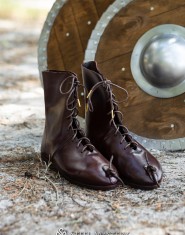About Medieval shoes
Among the earliest as well as most universal Middle Ages footwear patterns were ordinary medieval leather boots – turnshoes, popular in Northern & Central Europe. Their construction is a leather piece sewn up to the shoe sole by inside seams. This way there was much less moisture leaking in through the seams so footwear’s life was prolonged. Turnshoes were actually used until XVI century.
Later shoe’s sole was separated, becoming thicker, more solid over time.
Numerous simple but reliable Viking boots artifacts survived. Accordingly, our collection is packed with them. Hedebu shoes, type 10, Hedebu boots, type 9, Hedebu boots, type 6, Medieval shoes from Middelburg, Medieval boots from Lund and even more. Actually, we’ve got almost all each and every one, even soft cute Viking boots from Hedeby version.
But Vikings weren't only people in turnshoes, just look at beautiful stylish Medieval shoes with a notch. Oh, don’t forget – you’ll need comfortable short chausses for them.
Also medieval people used clogs – protective wooden sandals and shoes. People usually put them over soft leather basic footwear and even more often than not – instead of it.
Then comes the Gothic period with poulaines where shoe’s tips go longer so as more pointed every day. To half a meter in fact. No jokes. However, it’s not all so crazy – just take a look at lady’s poulaines from Gdansk. We also recommend wearing sexy Medieval women's stockings to complete the look (keep in mind choosing cast buckles for its straps).
The very reverse of the long-nosed poulaines in Medieval times were landsknecht or Tudor shoes, also called "bear paws". First worn by Swiss & German mercenaries, lightning-fast these became a fashion trend. In the late XV-early XVI century, men and women wore them all over Europe.
Eventually, renaissance shoes came with their high-heels for both men and women. Keep in mind that renaissance boots are romantic and brutal men fashion schtick. Just like absolutely cool Hessian boots.
So have no doubt – our wonderful cobblers have over 15 years of experience producing authentic handmade medieval boots. Quality, best materials, individual approach to each order is our motto. All you need – make a choice and place an order. Everything else is on us.
If something’s wrong with your order, Steel Mastery’s cobblers will rework your order following your wishes absolutely for free. Just return your order to us at your own cost.
In case you want some unique custom boots, contact us via [email protected], send your pictures and description – we’ll produce it for you as soon as possible.







